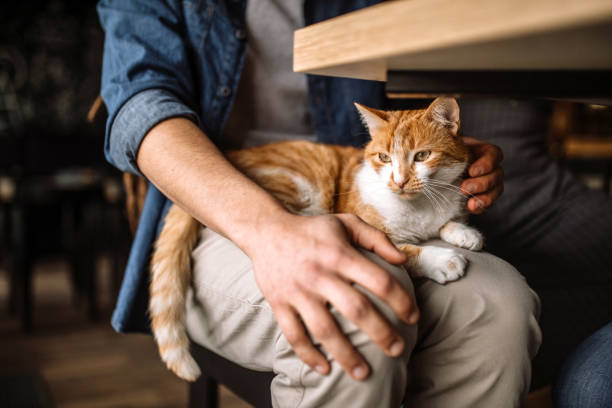How to Train a Cat to Sit on Lap

To train a cat to sit on your lap may seem like a daunting task, particularly if your pet cat is known for its independent nature. Nonetheless, by following some easy steps, you can teach your cat to associate your lap with comfort and relaxation.
Cats, like humans, benefit greatly from physical contact and a strong bond with their owners. Sitting on your lap not only allows your cat to get close to you, but it also helps them feel secure and comfortable in your presence.
In this article, we will explore some effective techniques for training your cat to sit on your lap, even if they are not accustomed to being held. By following these simple steps, you can create a positive and rewarding experience for both you and your pet.
Understanding Your Cat’s Behavior
In order to effectively train your cat to sit on your lap, it’s essential to take the time to understand their behavior. Cats are known for their independent nature, and they have their own set of instincts and habits that are different from other pets. Before you begin training, it’s important to note that some cats are more sociable than others and may take to lap-sitting more easily.
Understanding your cat’s body language is crucial when it comes to interpreting their behavior. Cats often display certain behaviors when they are happy, anxious, or agitated, so it’s important to pay attention to the subtle cues they give off.
Some common signs of anxiety or discomfort include flattened ears, dilated pupils, and a flicking tail. In order to make your cat feel comfortable sitting on your lap, it’s important to create a calm and relaxed environment. You may need to take things slowly, allowing your cat to become familiar with you and their surroundings before attempting to train them to sit on your lap.
By taking the time to understand your cat’s behavior and body language, you can create a comfortable and safe environment that will encourage your cat to feel at ease sitting on your lap. With patience and persistence, you can successfully train your cat to become a lap cat and strengthen the bond between you and your feline friend.
Building Trust with Your Cat

Establishing a strong bond with your cat is crucial in training them to sit on your lap. Building trust can take time, especially if your cat is shy or nervous. Start by spending time with your cat in a relaxed environment where they feel safe and secure, such as a quiet room in your home. Offer them their favorite treats or toys to create a positive association with you.
As your cat becomes more comfortable, gradually move closer to them and offer gentle strokes or pets. Be sure to read your cat’s body language to understand when they are enjoying the attention or when they need space. If your cat seems anxious or uncomfortable, give them time to adjust and try again later. Rushing the process can lead to setbacks in building trust, so it’s important to be patient and understanding.
Remember, building trust with your cat is not just about physical touch and treats, but also about being a reliable and consistent presence in their life. Spend time with them regularly, play with them, and show them affection in a way that they enjoy. Over time, your cat will come to trust you and feel more comfortable sitting on your lap.
Creating a Positive Association with Sitting on Your Lap
Before attempting to have your cat sit on your lap, create a positive association with the act of sitting on your lap. This can be done by offering your cat treats or toys while sitting in the desired location, such as a favorite chair. This will help your cat associate sitting on your lap with positive outcomes.
To further reinforce this positive association, you can also use a soft blanket or cushion on your lap to make it more comfortable for your cat. Encourage your cat to explore the blanket or cushion by placing treats on it. Over time, your cat will come to associate sitting on your lap with comfort and security.
It’s important to note that not all cats enjoy sitting on laps, and some may never take to it. If your cat is not interested in sitting on your lap, respect their preferences and find other ways to bond with them.
Start Small: Train Your Cat to Sit on a Nearby Object
Once your cat is comfortable with your presence and has a positive association with sitting in the desired location, begin training by having your cat sit on a nearby object, such as a cushion or stool. Use treats or toys to encourage your cat to sit on the object and reward desired behavior with praise and affection.
Gradually Moving to Sitting on Your Lap:
Once your cat is comfortable sitting on a nearby object, slowly move the object closer to your lap. Continue to reward desired behavior and offer positive reinforcement. Eventually, your cat may feel comfortable enough to sit on your lap.
Rewarding Desired Behavior:
When your cat sits on your lap, reward them with praise and affection. This will reinforce the positive association with lap sitting and encourage your cat to repeat the behavior. It’s important to reward desired behavior immediately to reinforce the association.
Patience and Persistence:
Training your cat to sit on your lap may take time and patience. Be patient with your cat and don’t rush the process. If your cat becomes uncomfortable or overwhelmed, stop and give them space. Gradual progress is better than rushing and causing your cat to feel stressed.
Common Mistakes to Avoid

When training your cat to sit on your lap, avoid forcing your cat to sit on your lap or holding them too tightly. This can cause your cat to feel threatened or uncomfortable. Additionally, avoid punishing your cat for not sitting on your lap as this will create a negative association with lap sitting.
Punishing your cat may cause your cat to avoid sitting on your lap altogether, making training more difficult. Instead, focus on rewarding your cat for desired behavior. This can be done through positive reinforcement techniques, such as giving your cat treats or praise when they sit on your lap. Over time, your cat will learn that sitting on your lap is a positive experience and will be more likely to repeat the behavior.
Another common mistake is to rush the training process. Cats can be slow to warm up to new experiences, so it’s important to be patient and take things at a pace that is comfortable for your cat. Start small, with short training sessions, and gradually increase the duration over time. It’s also important to be consistent with your training and to stick to a regular schedule to help your cat establish a routine.
By avoiding these common mistakes and using positive reinforcement techniques, you can successfully train your cat to sit on your lap and enjoy a close bond with your furry friend. Remember to be patient and persistent, and always listen to your cat’s cues to ensure they are comfortable and happy.
Conclusion and Final Tips for Success:
Training your cat to sit on your lap can be a rewarding experience for both you and your cat. By understanding your cat’s behavior, building trust, creating a positive association, starting small, rewarding desired behavior, and being patient and persistent, you can successfully train your cat to sit on your lap.
Remember to avoid common mistakes and offer your cat plenty of space and positive reinforcement. With time and patience, your cat may become a lap cat in no


